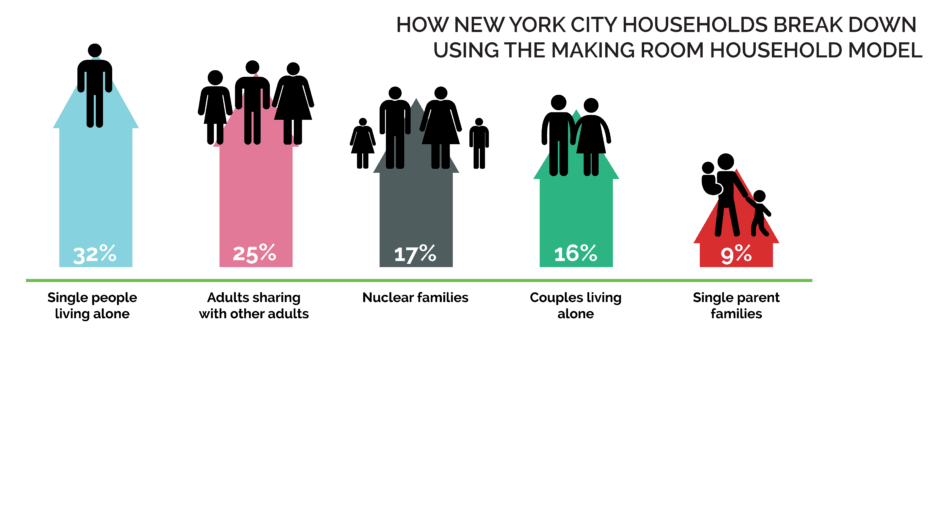Single people living alone, and adults sharing their homes with other adults, account for most households in New York City.
Making Room
Making Room began when CHPC created a unique data model that revealed the diversity of household configurations in 21st-century America. CHPC found that single people living alone, and adults sharing their homes with other adults, comprise the majority of households in each New York City and the United States. Despite this, the housing stock is designed primarily to accommodate nuclear family households, largely due to regulatory requirements in zoning and building code that prevent different housing typologies from being created.
Over ten years, CHPCs research and education initiative have built off of these concepts to create a new approach for policymaking and planning that can be applied anywhere. CHPC has promoted Making Room at educational events and venues nationwide, including symposia, housing design competitions, and exhibitions at the Museum of the City of New York and the National Building Museum. Making Room has made substantial impacts on housing policy in New York City, inspiring an innovative City pilot to develop a building of micro-studios, now known as Carmel Place, and leading to significant changes in the regulation of housing development by New York City zoning.
The Making Room approach to policymaking and planning asks:
1) How is the population grouping itself into households?
2) What are potential options for housing typologies that can support new household arrangements and lifestyles?
3) How can zoning, planning, subsidy, and building code controls change so that the development of new housing typologies is allowed and even encouraged?


One Size Fits Some International Symposium
In 2009, CHPC hosted an international design symposium at the Japan Society to acquaint New York City housing policymakers and industry practitioners with innovation in housing design occurring around the world, in response to changing demographics, a growing population of single people, and increased urbanization.
The first Making Room paper in 2010 launched the project’s new name and set out why policymakers and the housing industry should care about the mismatch between households and housing units.

Making Room Design Symposium, 2011
In 2011, CHPC partnered with the Architectural League of New York to commission developer/architect teams to take on a unique challenge: to design an array of accommodating, desirable, safe units for singles, shared households, and extended families, without needing to comply with certain regulatory restrictions, including minimum unit size, density restrictions, and occupancy standards. The results were presented at a follow-up symposium at teh Japan Society of New York.
Take a Virtual Tour Around the Making Room Exhibition! at the Museum of the City of New York in 2013!
Many other CHPC publications and initiatives were spawned from the Making Room initiative

Making Room National Exhibition, 2017
In 2017, CHPC was asked to curate an exhibition at the National Building Museum in Washington DC in partnership with Resource Furniture and AARP. The exhibit set out CHPC's unique demographic analysis, explored socio-economic trends for the demographic changes, presented a number of innovations from around the country for small, shared, and accessory dwelling units. Finally, CHPC and Resource Furniture designed and built a full-scale flexible three-bedroom home that could be converted for a variety of households!








